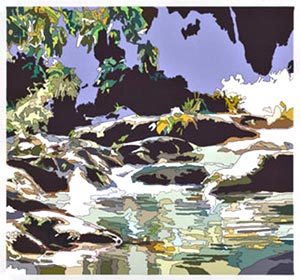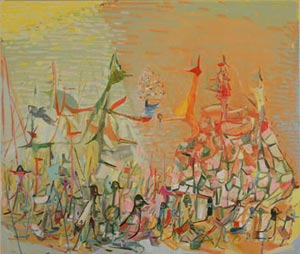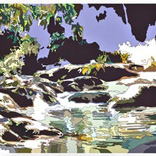The 2006 IKEA catalog has an art section. It’s about what you would expect: flowers, rocky seashores, childlike abstraction.
It’s got that pleasant blandness IKEA has mastered, appealing to high and low tastes alike, hitting nearly everyone’s comfort zone with a double-whammy of restrained elegance and playful Swedish novelty.
Anyone who really thinks art need not transcend appealing decoration can shop there: you don’t have to be rich, just smart. But I think art does need to transcend, and so do the artists in Landscape Confection, despite the exhibition’s coy embrace of style without substance.
Justin Gubbiotti’s Inferior Mechanics is a loungey painting full of the retro blobs which adorn the splash pages of platoons of over-designed websites. The ostentatiously raw exposed staples and ravelling canvas edges suggest another, funnier dimension to Gubbiotti’s work in which poor carpentry mitigates modish imagery; but of the three works on display, Inferior Mechanics is the only piece which could work this way. The other two are unrelievedly slick.
Rowena Dring‘s appliqué paintings and Kori Newkirk‘s beaded curtains take humdrum scenic images and translate them into a meticulously crafted objects, adding a layer of handwork to otherwise forgettable pictures. It’s a good shtick; but both artists” works fall flat, their very professionalism downplaying the craft processes they rely on for interest.
Neal Rock‘s silicone salads combine the sheen of raw calamari with the queasy fascination of a beached jellyfish. It’s a luscious technique, but Rock wastes it on inarticulate humps and lines. Katie Pratt‘s Spin Edge has a yeasty, festering quality. Pia Fries” combines photo images with massive bouts of sculptural paint. But all three of these artists are doodling, looking for a mass of goo which will justify itself, and the critical mass necessary for it to work is way beyond the safe, relatively convenient pieces on display.
Janaina Tschäpe‘s untitled wall piece is full of aimless twirls in bright primary colors. They vaguely recall seeds, internal organs, bubbles — but are too timid and methodical to elicit any joy. It’s just another flaccid biomorphic abstraction, unredeemed by gloppy plasticine, or the faintly transgressive act of smearing it on the wall.
Jim Hodges” Endlessly frames 13 forgettable pictures and hangs them as-is asks forlornly if there isn’t some way to reconcile these innocent snapshots with the demands of high art. Fall leaves, ripples on water, lace curtains, desert sand, Hodges catalogs the ultra-stereotypical, showing us what’s special about objects which everyone knows are special already. Like his flower curtain, Hodges dares us to enjoy and not ask for more; but each piece is also a lament that it’s not quite possible. Endlessly is interesting to think about, but in the end it’s just a grid of trite-but-appealing photos.
If you can stomach the assertion that stylistic innovation is no longer the sine-qua-non of good art, the four representational painters in the show fare well, using imagery as a framework on which to hang their painterly gymnastics:
Lisa Sanditz‘s rowdy paintings are like folk art quilts, juxtaposing curious narrative details with lighthearted painter’s gimmicks. 49th and Clark St. Park, Oakland California places an thatch of tangled trees, old sneakers and other junk across a patchy background like a sideways Hans Hoffman abstraction.
David Korty fills photoreal pencil drawings with dabs and drips of cotton candy paint, to make delicate pattern paintings like melting cakes with a moody sense of splendid decline.
Michael Raedecker‘s glum, lumpen Blind Spot combines fiber and paint to create a flattened diorama. A yarn cabin stands by a lake. An oval of grayish, wiry hair possibly peeled from an old man’s chest hovers morosely over the rickety dock. Modest, gray, and cryptic, Raedecker’s paintings stand in contrast to the self-conscious showiness of much of the work in Landscape Confection.
Amy Sillman‘s works re-hash historical painting styles with authority. Each painting tells a jumbled story like an un-captioned newspaper photograph in the painterly calligraphy New York has been hungry to re-legitimize and sell ever since the glory days of 1950’s and 60’s. In The Egyptians, schematic surrealist figures exchange gifts amid a knee-high flock of expressionist ducks. Behind them, a wickerwork of horizontal bars and vertical masts mimics an impressionist seascape. Sillman’s deft brushwork delights the eye, while the story gives you something to think about.
In the end, the polemics of Landscape Confection are all wrapped in a problem which doesn’t really exist. The show boldly champions decorative painting only to find that the prison door was battered down decades ago, then varnished and used as a bar-top. Decorative painting sits, nursing yet another piña colada. Aside from a few hypocritical party-poopers, no one ever said there was anything wrong with making good art pretty. But it is necessary to make it pretty good.
Images courtesy Contemporary Arts Museum.
Bill Davenport is an artist and writer, and was the first contributor to Glasstire.






